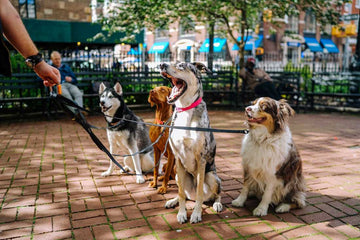
Walking your dog should be a time for exercise, bonding, and fresh air, but for many dog owners, it can turn into a frustrating scavenger hunt. Whether it’s sticks, grass, trash, or even chicken bones, your dog seems determined to find and munch on anything they can sniff out. While scavenging is a natural behavior rooted in a dog’s instincts, it can quickly turn your peaceful walk into a challenge. But you don’t have to accept defeat to this behavior.
With the right strategies, you can manage your dog’s scavenging habits and turn walks back into enjoyable, focused exercise sessions.
What is Canine Scavenging Behavior?
Dogs are natural scavengers, a trait that hails from their wild ancestors. In the wild, dogs would scavenge for food in the environment, relying on their instincts to find whatever they could. This behavior was vital for survival, helping them locate food when prey was scarce. Even domestic dogs, who are regularly fed and have access to their own food, retain these instincts. Scavenging on walks allows them to satisfy their inherent need to search and explore for different smells and tastes, such as discarded food or even items like sticks and grass.
However, scavenging is not just about food. Dogs, especially breeds with strong hunting or tracking instincts like hounds, may be driven by boredom or a need for mental stimulation. If your dog isn’t getting enough engagement during walks or is feeling over-aroused, they may start scavenging to entertain themselves or release excess energy. Boredom in dogs can lead to various unwanted behaviors, and scavenging is one of them. When your dog is constantly searching for something novel to eat, it’s often a sign that they’re not getting enough variety or stimulation in their daily routine.

How Do I Stop My Dog From Scavenging?
If your dog frequently interrupts your walks to scavenge, don’t worry! With patience and consistency, you can teach your dog to focus on you and ignore distractions.
Teach “Leave It” and “Drop It” Commands
Training your dog to obey basic commands like “leave it” and “drop it” can be a game-changer. These commands teach your dog to focus on you instead of whatever they have found on the ground. Begin training at home with low-distraction items, gradually working up to more tempting objects during walks. Reward your dog with treats and praise when they successfully follow your command.
Use Positive Reinforcement
When your dog ignores something they want to scavenge, reward them with a treat, praise, or a toy. Positive reinforcement helps reinforce good behavior and encourages your dog to focus on you rather than the distractions around them. This approach allows your dog to associate good things with ignoring temptations.
Reward Focus and Attention to You
Another effective method is rewarding your dog for maintaining eye contact or focusing on you during walks. When your dog’s attention is on you, they are less likely to scavenge. Carry treats or toys to offer rewards when your dog looks up at you, reinforcing their attention and making it a habit to stay focused on you.
Avoiding Temptations for Fewer Scavenging Opportunities
While training is essential, it also helps to reduce the likelihood of temptations. Here are a few practical steps to make walks less enticing for a scavenging dog.
Choose Walking Routes
Walk in areas that are clean and free from food waste, trash, or other items your dog might want to eat. Areas with minimal litter or food sources will reduce the chances of your dog encountering things to scavenge. Stick to sidewalks or well-maintained trails where food debris is less likely to be found.
Redirect Scavenging
If your dog has a strong desire to scavenge, you can give them an outlet at home. Snuffle mats, treat puzzles, and hidden treats can provide a satisfying and safe way for your dog to express their natural scavenging behavior. This allows them to explore different smells and flavors without ingesting harmful items during walks.
Provide a Balanced, Varied Diet
Sometimes, a dog’s urge to scavenge can be linked to hunger or a lack of variety in their diet. Provide your dog with nutritious, complete, and fulfilling meals. Feeding your dog before walks can help reduce food-driven scavenging urges, as they’ll be less likely to look for scraps. Additionally, a varied diet with different protein sources can keep your dog from becoming bored with their food.
Make Sure Your Dog is Fed Before Walks
Ensure your dog has had a meal not long before you head out the door. If your dog feels full and satisfied, it’ll be less likely to hunt for food. You can even make mealtime more interesting by using slow feeders or snuffle mats. These tools engage your dog’s brain while they eat, slowing down the process and satisfying their scavenging instincts.

Training Strategies to Stop Eating Unwanted Items
In addition to basic training, there are other strategies to address your dog’s scavenging behavior.
Muzzle Training
For dogs with particularly strong scavenging tendencies, you can prevent them from eating unwanted items while still allowing them to pant and drink water. Muzzle training should be done gradually to make your pet comfortable wearing it.
Slow Eating
Consider using special slow feeders or treat tumblers during mealtime to encourage a slower, more deliberate approach to food. These tools help slow down your dog’s eating, encouraging them to engage more with their food. When your dog eats slower, it can also reduce their desire to scavenge for something more exciting.
Mental Stimulation
Providing mental stimulation can help prevent boredom, which is a primary trigger for scavenging behavior. Try activities like “Find It” or “Which Hand” to get your dog using their nose and brain during walks. These activities are great for exercising your dog mentally, making them less likely to scavenge.
Managing Scavenging on Walks
Managing your dog’s scavenging behavior requires constant vigilance and control. Here are a few tips to help manage the temptation during walks.
Recognizing Cues: Look for signs your dog might be about to scavenge, such as sniffing the ground or a wagging tail. Early recognition of these cues allows you to redirect your dog’s attention before they get too focused on the temptation.
Interactive Toys: Bring puzzle or interactive toys to keep your dog’s mind engaged. These toys provide entertainment and mental stimulation, reducing the likelihood that your dog will stop to scavenge.
Be Prepared: Always have a plan for unexpected temptations. Carry treats to redirect your dog or a toy to distract them. Being prepared for distractions ensures you stay in control of the situation.
Leash Control: A short leash gives you more control during walks. It also reduces the chances of your dog wandering off and getting too close to potential food sources.
Protecting Your Dog from Scavenging
Constant supervision is key to keeping your dog safe from scavenging harmful items. Watch your dog closely, especially in areas with known temptations, like parks or trash-laden streets. Additionally, using safety equipment like a basket muzzle can prevent your dog from ingesting harmful objects like chicken bones, potentially leading to serious health issues.
Medical Considerations for Scavenging Behavior
Scavenging behavior may sometimes be linked to medical conditions. If your dog is persistently scavenging despite your efforts to manage it, it could indicate an underlying issue like gastroenteritis, parasites, or even pica, a disorder where dogs eat non-food items. Consult your vet immediately if you see your dog eating unusual objects like plastic, paper, or rocks. Conditions such as heartburn, pancreatitis, or indigestion may also cause your dog to seek out food to relieve discomfort. A vet can help rule out medical causes and suggest a course of treatment.

How Using Grass Pee Pads for Dogs Can Help Prevent Scavenging
Dog grass pee pads can also play a role in managing your dog’s scavenging habits. By providing designated areas for your dog to relieve themselves, these pads help reduce the temptation to scavenge during walks. When your dog is given a specific place to go to the bathroom, they are less likely to be distracted by other animals’ scents or discarded food along the way.
Do Dogs Grow Out of Scavenging?
While some dogs may grow out of scavenging with age or through consistent training, many will always have a tendency to scavenge. This behavior is rooted in their instincts, and while you can reduce its intensity, it may never disappear entirely. With patience and training, however, you can significantly reduce how often your dog scours the ground during walks.
Final Thoughts
Understanding that scavenging is a natural canine behavior is the first step toward managing it. Strategies like consistent training, removing temptations, and providing mental stimulation can help curb the urge to scavenge. Always consult your vet to rule out any underlying medical issues, and consider products like Gotta Go Grass to create a designated indoor bathroom spot for your dog. That way, you can keep your walks focused on exercise and bonding—not bathroom breaks or scavenging detours.
With patience and persistence, your daily walks can become enjoyable, distraction-free routines. By addressing scavenging behavior head-on, you can keep your dog safe, healthy, and happy.
Explore natural grass pad solutions from Gotta Go Grass and find expert tips for potty training, pet care, and confident pet ownership—all in one place.




